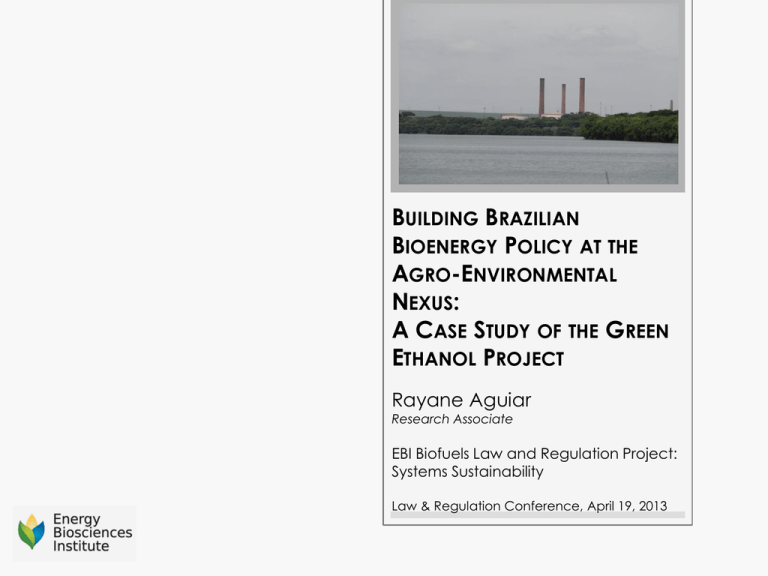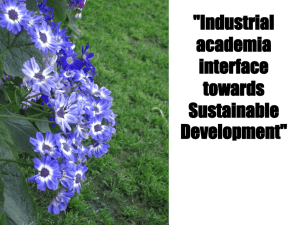Slides - Biofuels Law and Regulation Conference
advertisement

BUILDING BRAZILIAN BIOENERGY POLICY AT THE AGRO-ENVIRONMENTAL NEXUS: A CASE STUDY OF THE GREEN ETHANOL PROJECT Rayane Aguiar Research Associate EBI Biofuels Law and Regulation Project: Systems Sustainability Law & Regulation Conference, April 19, 2013 Presentation Roadmap 1. Why the sustainability conversation in Brazil? • Policies that have fostered the bioenergy sector • Accompanying sustainability concerns 2. Case study: SP's Green Ethanol Project 3. Concluding Thoughts Why Focus on São Paulo? • 54% of Brazil’s sugarcane = 304 million tons • 51% of Brazil’s ethanol = 11.6 billion L • SP: around 190 usinas • • Brazil: more than 440 usinas SP: 5.2 million ha • BR: 9.6 million ha • Most advanced regulation and policies • R & D concentration Source: UNICA and UDOP (2011/2012 harvest season) The Brazilian Regions and States Sustainability Conversation Drivers: • National Drivers: 1. Pro-álcool 2. Ethanol Blending Mandate: 20-25% 3. Flex Fuel Cars 4. Brazilian Renewable Energy Policies • PROINFA – Biomass to electricity • Biodiesel: PNBP • 5% blending mandate • 2.4 billion L Sustainability Conversation Drivers: • International Drivers: 1. The European Renewable Energy Directive 2. California's LCFS • Both recognize Brazilian sugarcane ethanol as an important player in achieving U.S. and EU targets in reducing GHG emissions • Sustainability concerns certification Sustainability Concerns • Land conversion for sugarcane expansion • Impacts on GHG emissions, biodiversity • Water quality and quantity • Air emissions (e.g., burning) • Soil degradation: erosion and quality • Waste management • Social concerns • Labor conditions and employment • Community benefits The Emergence of Standards • International and national standards • Brazil-based 1. BONSUCRO: • EU-RED qualified • Currently certifies over 1 bil. L • 26 companies in Brazil 2. SP Green Ethanol Project • 159 usinas participating • 27 farmer associations São Paulo's "Etanol Verde" Program São Paulo's Etanol Verde Program • • • 2007: Agreement SMA-SP, SAA-SP, industry and associations Main goals: • Address land conversion • Protect/restore riparian areas and headwater areas • Eliminate sugarcane burning • Soil management • Water quality and quantity • Reducing GHG emissions • Ag residues & usina by-product management Less complex/ less expensive/ high rate participation Etanol Verde Program Implementation • Certification process: • Strategic Plan • • Details, goals and deadlines • Committee: SMA, SAA and UNICA • Reviewed annually (renew or cancel) All the information provided can help authorities to better shape future policy strategies (adaptive management) • • Etanol Verde Program Provision 1: Land Conversion Brazilian Environmental Policy • Requires permitting of ethanol Agro-environmental zoning: SMA-SP & SAA-SP • Soil, climate, water quant/qual, conservation units, ecological corridors, native vegetation • Categories: • Suitable • Suitable with environmental limitations • Suitable with environmental conditions • Unsuitable(slopey and remains of Atlantic Tropical Forest) SP Sugar Cane Zoning Etanol Verde Program Provision 1: Land Conversion • According to the Agro-environmental Zoning Plan: • 1%: unsuitable areas: no-go areas • 45%: suitable w/ environmental limitation • 28%: suitable w/ environmental constraints • 26%: suitable areas • SC expansion on suitable areas has to follow certain conditions: SMA Res. 88/2008 Etanol Verde Program Provision 2: Riparian and Headwaters Areas Protection • Brazilian Forest Code leading policy • Preserve the environment and protect biodiversity • APP: permanent protection areas • Riparian area restoration plan: voluntary • Restore vegetation of headwaters areas: 50m perimeter 10% per year Etanol Verde Program Provision 3: Burning Prohibitions and Mechanization Law 11,241/2002 AgroUntil 2013 environmental 2.7 mil tons CO2eq Protocol emissions 2021 mechanized 2014 mechanized 4.5 million ha mechanized 2031 nonmechanized (slopey) 2017 nonmechanized (slopey) 1.67 million ha burning • No burning on areas of SC expansion • CETESB role Municipalities versus protocol deadlines • Class Actions: • • State public prosecutors • Requiring immediate stop • State Court decisions Federal public prosecutors • Analyses of feasibility • Requiring EIA/RIMA: CETESB • Federal Court decisions Mechanization Issues • Sugar cane yield losses • Cost increase: • Logistics Mechanization Issues • Technology - small farmers? • Job displacement • Soil degradation • Lack of extension programs for technology transfer • Pest control problems Etanol Verde Program Provision 4: Soil Quality and Erosion • Soil conservation plan containing: • Soil erosion control practices • Crop rotation • Incorporation of residues (palha) • • Sugar cane leaves (palha): 15 ton/ha Return sand back to soil after SC harvesting (3% of total harvested material) Etanol Verde Program Provision 5: Water Quality and Quantity • Water Sources Conservation Plan (annual) • Usinas have primary responsibility • Plan must address quantity and quality • Reduce consumption (1m3/ton of SC) • Reutilization & closed cycle Etanol Verde Program Provision 6: Industry By-Products Management Etanol Verde Program Provision 6: Industry By-Products Management • • • Bagasse electricity Juicing process filter material and boiler ash fertilizer Vinhaça Fertirrigation • Vinhaça Use control Plan: annual • Vinhaça & soil nutrient measurement • Protect surface and ground water Concluding Thoughts • Brazilian ethanol industry has shown great improvements in sustainability • Due both to market imposition and more stringent regulatory and enforcement systems, particularly for usinas • BUT, “sustainability” practices have negatively affected small scale producers and caused land and market concentration • Policies and extension programs targeting sugar-cane small scale farmers are lacking • Public and private investments in RD are key to developing tools that improve sustainability within the production chain Thank you! raguiar@illinois.edu Rayane Aguiar Research Associate, The Energy Biosciences Institute ZAE-CANA: 64.7 million ha 53% pasture lands Cattle stocking rate = 1.1 head per ha (Censo IBGE, 2006)










